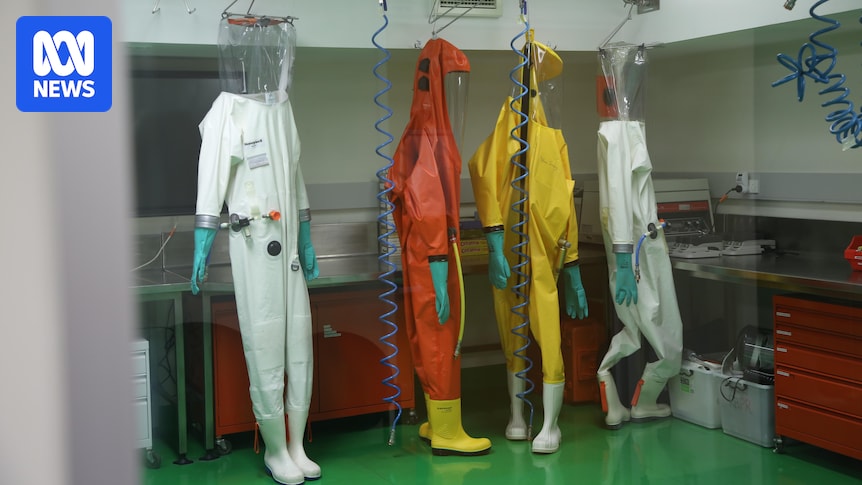
When Jennifer Barr arrives at work each morning, she navigates through a rigorous security protocol that includes half-a-dozen checkpoints, clothing removal, and passage through two steel airlocked doors. Once inside, she dons freshly washed medical scrubs and, if heading into the lab, a fully encapsulated suit with a separate air supply, reminiscent of astronaut gear.
This meticulous routine is necessary because this is no ordinary lab. It is the CSIRO Australian Centre for Disease Preparedness (ACDP) in Geelong, a facility equipped with the highest biosafety level to handle highly transmissible and potentially lethal pathogens, such as Ebola and Hendra virus. “The suits protect us from the dangerous viruses that we’re working with,” said Mrs. Barr, who leads the Pathogen Investigation Team at the ACDP.
The High-Containment Facility
First opened 40 years ago, the ACDP is one of only a few high-containment facilities in Australia and the sole location capable of handling infected livestock at the highest biosecurity level. “There’s so much engineering and so many procedures to ensure safety, even though the viruses we’re working with are not safe,” Mrs. Barr explained.
Recently, the ABC was granted a rare glimpse inside this facility. From the outside, the ACDP appears as a large, grey industrial building. However, its high-security fences and quarantine signs hint at the critical work conducted within. Inside, a microbiologically secure area is encased by a 30-centimetre thick concrete wall, accessible only through airlocked doors.
A Fortress of Safety
Within this secure zone are several high-containment laboratories maintained at lower air pressure than the outside world to ensure air flows inward, minimizing the risk of virus escape. “We have a box in a box in a box, which means multiple layers of containment with increasing negative pressure,” said ACDP director Debbie Eagles.
The building’s five floors are strategically designed, with four dedicated to supporting the lab operations on the third floor. “The designers consulted international facilities, including NASA, to understand quarantine and containment requirements,” Dr. Eagles noted.
The secure area includes an insectary for studying insect-borne diseases and a large animal facility for working with infected livestock. “We can hold animals ranging from chickens to cattle and horses,” Dr. Eagles explained. The third floor also features a laundry service and a kitchen, enabling scientists to remain in the secure zone throughout the day.
“Absolutely everything that leaves this place gets treated in some way, ensuring the pathogens we’re working with stay inside,” Dr. Eagles said.
Responding to Outbreaks
Originally built as an animal health laboratory, the ACDP plays a crucial role in responding to animal disease outbreaks by providing rapid diagnostic tests and genetic analysis. “We receive samples for everything from avian influenza to African swine fever,” Dr. Eagles stated.
In 2024, avian flu outbreaks across Victoria, NSW, and the ACT led to millions of birds being culled, severely impacting the nation’s egg supply. ACDP scientists used genetic testing to identify circulating bird flu strains and assist authorities in understanding their behavior.
“If we weren’t able to diagnose them, we wouldn’t be able to respond to them or control the virus,” Dr. Eagles emphasized.
Scientists at the facility also focus on regionally important viruses threatening Australia’s livestock and aquaculture industries, such as lumpy skin disease and Japanese encephalitis. Beyond diagnosis, the high-containment labs enable research into disease development and spread, as well as testing new vaccines and therapeutics.
Historical Successes
During the COVID-19 pandemic, the ACDP conducted pre-clinical testing of the AstraZeneca vaccine. One of the center’s notable achievements was isolating and identifying the Hendra virus in 1994, following a deadly outbreak in Queensland. “We contributed to developing a vaccine that protects horses and their owners,” Dr. Eagles said.
Preparing for Future Pandemics
Research indicates a rising incidence of emerging infectious diseases in humans, with 75% estimated to originate from animals. Consequently, the ACDP collaborates with health agencies to prepare for future pandemics. “We’re contributing to the surveillance of diseases circulating in wildlife, helping us prepare for ‘Disease X’,” Dr. Eagles explained.
Research scientist Lynn Nazareth is working on understanding how viral infections spread through the nasal cavity. “I grow the inside of the human nose in a dish to assess the threat of bird flu,” Dr. Nazareth said.
“While it predominantly affects animals, bird flu can spread to humans, and the recent spread of the H5N1 strain has experts concerned about its pandemic potential,” Dr. Nazareth noted.
End of the Day Routine
As the day concludes, scientists at the ACDP undergo a thorough decontamination process. They take a four-minute chemical shower in their biocontainment suits, followed by a water rinse, before changing out of their medical scrubs. After another personal shower, they exit the secure area, ready to return the next day.
Tomorrow, they will repeat this process, continuing their vital work in protecting Australia from infectious disease threats.







